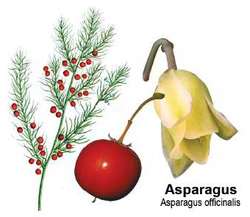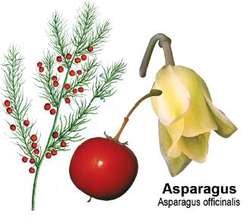asparagus
(redirected from Asparagus plant)Also found in: Dictionary, Thesaurus, Medical.
asparagus
asparagus
Asparagus
a genus of branching perennial herbs, subshrubs, and lianas of the family Liliaceae. The leaves are reduced to scales, whose axils bear greatly modified branchlets, or cladodes. The cladodes are often gathered into bundles, and in some asparagus species phylloclades are observed. The small flowers are for the most part diclinous; the fruit is a berry.
There are about 300 species of asparagus, distributed in the Old World, mainly in arid regions. The USSR has about 30 species. The common, or garden, asparagus (A. officinalis) is of the greatest economic significance. It is a dioecious plant. There are some specimens, however, that bear male flowers on some of the stems and female flowers on others; bisexual flowers may occur along with unisexual ones. The common asparagus grows wild in Western Europe, the Mediterranean region, the Balkans, the European USSR, the Caucasus, and Western Siberia. The plant is cultivated in Western Europe, India, Japan, Northeast China, Algeria, Egypt, the USA, and the USSR. Cultivation of the crop in the USSR is on a small scale and is concentrated in the central and southern zones of the European USSR, the Northern Caucasus, Transcaucasia, and the Crimea.
The common asparagus was cultivated initially as a medicinal plant and later as a vegetable crop (var. altilis). The stem is 120–150 cm tall. Suitable for food are the young, juicy, etiolated underground stalks (white asparagus) and the young above-ground stalks that reach a height of 15–20 cm (green asparagus). Asparagus stalks contain about 2 percent protein and 2.4 percent carbohydrates (not counting cellulose). The vitamin content is as much as 40 mg percent vitamin C, 0.19 mg percent vitamin B¡, 0.14 mg percent vitamin B2, 1.0 mg percent vitamin PP, and 1.3 mg percent provitamin A (more than in tomatoes or cabbage). Asparagus may be boiled, sautéed, or canned; it may also be used as a coffee substitute. The roots and young stalks contain the alkaloid asparagine, which is used medicinally.
There are numerous varieties of the common asparagus, which are divided by color into three groups: green-tipped (Snow Head, Spanish), red-tipped (Argenteuil Early and Late are the most common and most productive), and white-tipped (Giant, Mammoth Columbian White).
Asparagus is propagated by seedlings; less frequently a shrub is divided to form new plants. The crop grows well on loose, fertile soils that have been treated with organic fertilizers (60–80 tons/ ha). The first stalks are harvested in the third season; the plantations are used until they are ten to 15 years old. Harvesting takes place in early spring. The aboveground stalks are cut, and the underground stalks are dug up and cut above the root collar (crown). The average yield is 30–35 quintals/ha. During the winter asparagus is raised in hothouses, hotbeds, and cellars from two-or three-year-old rhizomes stored since autumn.
In Japan the species A. colchinchinensis is cultivated. Candy is made from the tubers, and the plant is also used medicinally. A number of asparagus species, including the asparagus fern (A. plumosus) and A. sprengeri, are often cultivated as ornamentals.
REFERENCES
Ipat’ev, A. N. Ovoshchnye rasteniia zemnogo shara. Minsk, 1966.Girenko, M. M. Sparzha. Leningrad, 1974.
Z. S. LEZHANKINA


